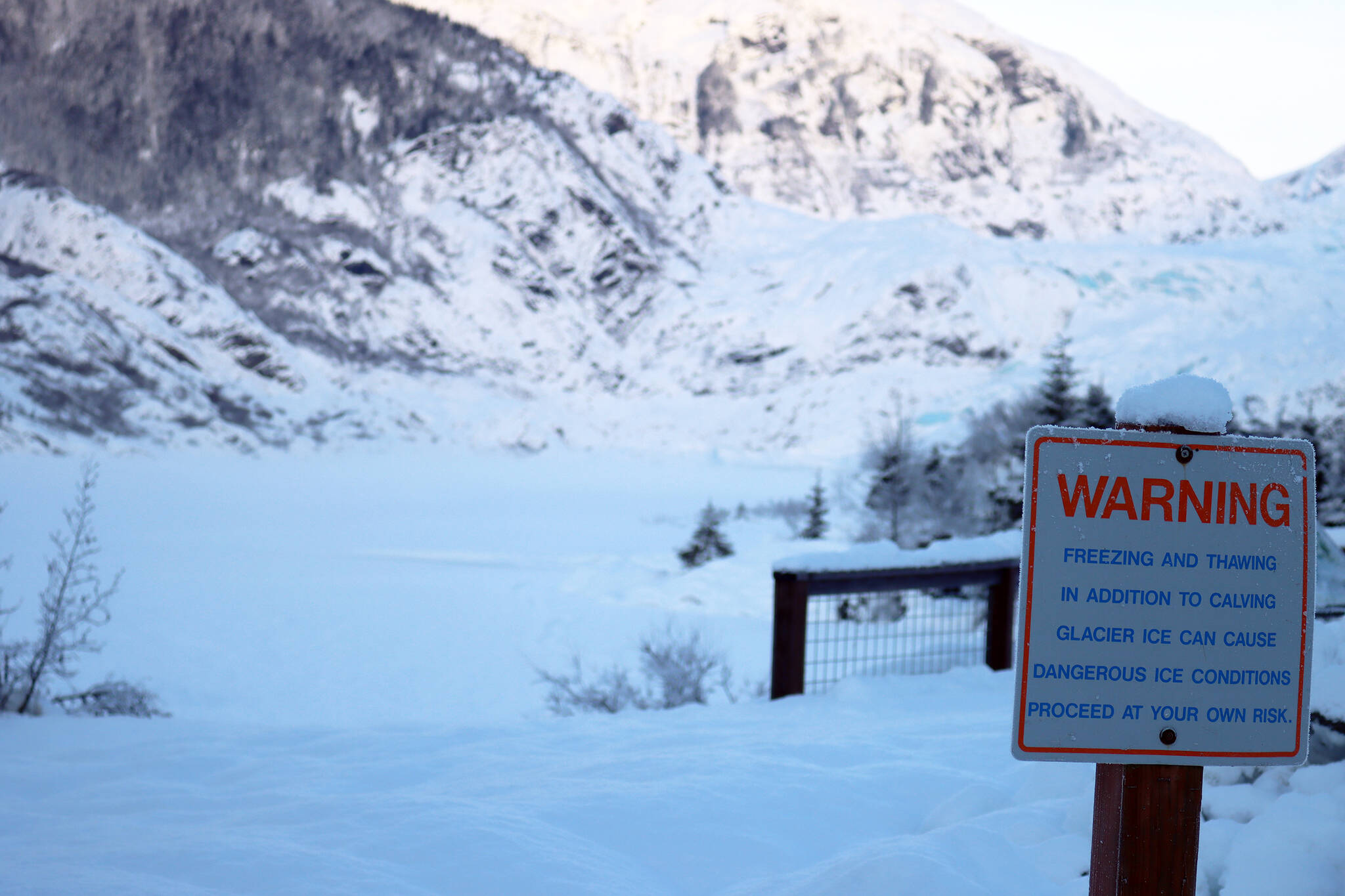As Juneau’s temperatures plunge from the merely cold to the bitterly frigid, Juneau residents may begin to eye the frozen lakes with athletic intent.
It’s still early to get out there, though, said Capital City Fire/Rescue Assistant Chief Travis Mead, and the ice should never be considered fully safe.
“We consider ice as always unsafe,” Mead said in a phone interview. “It’s such a dynamic situation when we talk about ice and there’s a lot of variables that come into play when we talk about how safe to be on.”
It’s not just one’s self that one needs to consider for safety, Mead said, but others with us, including pets.
“We’ve already had a dog fatality out on the ice,” Mead said. “The ice at the shoreline was strong enough for the dog to get out on, and we’re talking a small dog, 6-pound dog, and it got out a hundred feet, and fell through the ice.”
[Grant process leaves city high and dry, but electrification plans still on deck]
The pet fatality, which occurred on the Mendenhall Lake, is a scenario that’s a common cause of concern for CCFR personnel, Mead said, with people attempting to rescue their pets and breaking through the ice themselves.
“Especially when there’s a dog involved. I highly recommend you call 911 and get us coming,” Mead said. “It’s always very traumatic and it’s a horrible experience to watch an animal die in front of you. As rescuers, we know if we don’t react there’s a risk of someone attempting to rescue it themselves.”
Don’t become a casualty
A little preparation can go a long way if you decide to go out on the ice anyway, Mead said, although the safest way to avoid going through is not to go on the ice at all.
“Resist the urge to get on the ice if you can help it,” Mead said. “What’s safe today might not be safe tomorrow.”
Failing that, it’s always good to tell someone where you’re going, no matter if you expect trouble or not, Mead said. The best practice if someone goes through the ice is to immediately call 911, Mead said. Having a line to throw, or ice spikes to pull yourself out can help make the difference, Mead said. Information to avoid going where the ice is dangerously thin can prevent you from needing to self-recover or help someone else out in the first place.
“We don’t consider it safe enough to walk on unless I have 6 inches of ice under my feet. I confirm that before I go out there with my kids, that there’s 6 inches,” Mead said. “Mendenhall Lake is going to freeze before Auke Lake, because it’s colder, but Mendenhall Lake has differences on different sides of the lake.”
Mead said he drills holes in the ice to test the thickness.
“I use an ice screw that’s about nine inches long. I test the ice every 50-100 feet,” Mead said. “I was about 300 yards from shore, with about consistent six inches of ice, and in about 50 feet, it dropped to about 2.5 inches of ice.”
Even the same lake can vary wildly in its thickness depending on flowing water or other localized conditions.
“You get anywhere near the face of that glacier and there’s so much movement going on, and you can never consider that solid. You get over by Nugget Falls and the amount of turbulent water, and the current under the surface, and it’s going to be thinner,” Mead said. “We recommend anyone who feels the need to go out on the ice, go out there with their eyes open and be aware it’s a risky behavior.”
Backtracking once you’re able to pull yourself clear is the best practice, Mead said.
“Go back the way you came, because the ice was thick enough to get you out there. If you can log roll away from the hole, that’s good,” Mead said. “If you can’t self rescue, get your arms and as much of your torso out of the water so we can find you and rescue or recover you.”
Rescue and recovery
For the CCFR personnel responding to a breakthrough, time is absolutely crucial, Mead said, as the victim is in the freezing water and air that could be much, much colder. Exposure can kill extremely rapidly, depending on the temperatures, the victim’s body composition, and how they’re dressed, Mead said.
“The moment there’s an emergency, call 911,” Mead said. “Time is extremely critical during those exposure situations.”
Calling 911 can give CCFR personnel enough time to get out to the incident site, Mead said. Personnel then need to get to the victim ready to act, which can take between 30-45 minutes at Mendenhall Lake, Mead said.
“The average response time from the fire department to the Mendenhall Valley is seven minutes. It does not include us getting on scene, getting dressed, getting our equipment, and getting out there,” Mead said. “The further you get from a drivable surface, the more you need to be prepared to save yourself.”
CCFR personnel receive hours of training each year on how to perform water rescues, accumulating more experience each year. Despite that, they only usually receive about one call a year for someone going through the ice, Mead said. “It’s not very often. As far as calls, it’s maybe once or twice a winter that we respond to something that’s ice-involved,” Mead said. “I do hear of people self-rescuing. It’s more often than we think.”
Best practices aside, it’s too early yet, Mead said.
“There’s no such thing as safe ice,” Mead said. “I drove by the glacier recently and I wouldn’t consider going on that for many more weeks of cold temperatures.”
• Contact reporter Michael S. Lockett at 757-621-1197 or mlockett@juneauempire.com.

